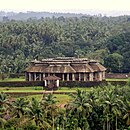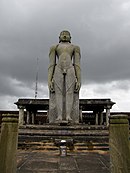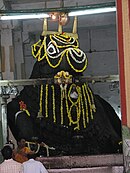List of Vijayanagara era temples in Karnataka
The List of Vijayanagara era temples in Karnataka includes notable and historically important Hindu and Jain temples and monoliths that were built or received significant patronage by the kings and vassals of the Vijayanagara Empire during the period 1336-1646 AD. This period includes the rule of the four dynasties: the Sangama, the Saluva, the Tuluva, and the Aravidu dynasties.
| Common name | Photo | Location | District | Year | Notes |
|---|---|---|---|---|---|
| Someshwara[1] | Kolar city | Kolar | Early 14th century | According to the Archaeological Survey of India the temple is assignable to the early Vijayanagara period | |
| Vidyashankara[2][3][4] | Sringeri | Chikkamagaluru | 16th century | According to art historian George Michell, the unusual stellate appearance of the temple is due to the influence of Hoysala architecture. | |
| Shiva[5][6] | Hemakuta hill, Hampi | Ballari | Early 14th century | Hemakuta group of temples, UNESCO World heritage site | |
| Shiva[5][6] | Hemakuta hill, Hampi | Ballari | 14th century | Hemakuta group of temples, UNESCO World heritage site | |
| Shiva[5][6] | Hemakuta hill, Hampi | Ballari | 14th century | Hemakuta group of temples | |
| Shiva[5][6] | Hemakuta hill, Hampi | Ballari | 14th century | Hemakuta group of temples, UNESCO World heritage site | |
| Shiva[5][6] | Hemakuta hill, Hampi | Ballari | 14th century | Hemakuta group of temples | |
| Ganagitti (Jain)[7][8] | Hampi | Ballari | c.1385 | An inscription on the site states that the temple was built in A.D. 1385 by lruga, in the reign of King Harihara II, UNESCO World heritage site | |
| Saavira Kambada Basadi[9][10] | Mudabidri | Udupi | c.1429–1430 | Known locally as the 1000-pillared temple | |
| Narayana[11] | Melkote | Mandya | c.1458 | Also known as Cheluva Narayana temple, it was built by the local Vijayanagara chieftain | |
| Narasimhaswamy[11] | Melkote | Mandya | c.15th century | According to historian George Michell, the massive gateway on the hilltop (gopura) is unfinished. | |
| Virupaksha[12][13][14] | Hampi | Ballari | 14th-16th centuries | UNESCO World heritage site | |
| Temple tank (Pushkarni)[15][16] | Hampi | Ballari | 16th century | Stepped temple tank in Hoysala style, UNESCO World heritage site | |
| Hazara Rama[12][13] | Hampi | Ballari | c.1406-1542 | UNESCO World heritage site | |
| Chandikeshwara[12][17] | Hampi | Ballari | c.1545 | UNESCO World heritage site | |
| Uddhana Virabhadra[17][18] | Hampi | Ballari | c.1545 | UNESCO World heritage site | |
| Pattabhirama[12][19] | Hampi | Ballari | c.1529-1546 | UNESCO World heritage site | |
| Alvar group[20] | Hampi | Ballari | c.1556 | Five temples were built for the Vaishnava saints Tirumangai, Mudal, Nammalvar, Tirumalishai & Ramanuja; UNESCO World heritage site | |
| Kallina Ratha[12][13] | Hampi | Ballari | c.1529-1546 | UNESCO World heritage site | |
| Achyutaraya[12][21] | Hampi | Ballari | c.1529-1546 | UNESCO World heritage site | |
| Sasivekalu Ganesha[12][22] | Hampi | Ballari | 15th century | UNESCO World heritage site | |
| Kadalekalu Ganesha[12][13][22] | Hampi | Ballari | 15th century | UNESCO World heritage site | |
| Prasanna Virupaksha[12][23] | Hampi | Ballari | c.1509 | UNESCO World heritage site | |
| Nandi monolith[12][24] | Hampi | Ballari | 15th century | UNESCO World heritage site | |
| Ugra Narasimha[12][13] | Hampi | Ballari | 15th century | UNESCO World heritage site | |
| Badavi linga[25] | Hampi | Ballari | 15th century | UNESCO World heritage site | |
| Mallikarjuna[26] | Hospet | Ballari | 1406–1422 | Located in Mallapanagudi, close to Hospet | |
| Vishnu[12] | Hampi | Ballari | 16th century | UNESCO World heritage site | |
| Chandrashekara[12][27] | Hampi | Ballari | c.1406-1446 | UNESCO World heritage site | |
| Balakrishna[12][13][28] | Hampi | Ballari | c.1509-1529 | UNESCO World heritage site | |
| Raghunatha[12][29] | Hampi | Ballari | c.1529-1542 | UNESCO World heritage site | |
| Vitthala[12][13] | Hampi | Ballari | c.1426-1542 | UNESCO World heritage site | |
| Virupaksha[30] | Virupakshi | Kolar | 15th century | ||
| Vijayendra | Bethamangala | Kolar | 15th century | ||
| Chaturmukha (Jain)[31][32] | Karkala | Uttara Kannada | c.1586-1587 | Literally means "four faced" temple. | |
| Bahubali monolith (Jain)[31][32] | Karkala | Uttara Kannada | c.1431-1432 | The monolith of Bahubali here stands twelve and half meters tall. | |
| Parshwanatha Basadi (Jain)[32][33] | Gerusoppa | Uttara Kannada | 1581 | The Basadi is also called Ratnatraya Badasi and was built by Rangapparajodeya. It has shrines for Neminatha, Parsvanatha and Vardhamana. | |
| Shantappa Naika Tirumala[34][35] | Bhatkal | Uttara Kannada | 1555 | Built by Shantappa Nayaka | |
| Virupaksha[34][36] | Gokarna | Uttara Kannada | 1570 | Built by Queen Virambika | |
| Bala Kini Raghunatha[34][37] | Bhatkal | Uttara Kannada | 1590 | Built by Bala Kini | |
| Khetapai Narayan[38][39] | Bhatkal | Uttara Kannada | 1540 | Built by local chief Ketapayya | |
| Bahubali monolith (Jain)[40] | Venur | Uttara Kannada | c.1606 | The monolith was built by the local Ajila Chiefs. | |
| Gangadhareshvara[41][42] | Shivagange | Bangalore rural | c.1600 | Shivagange was the principal seat of the Gowda rulers, the founders of Bangalore. Portraits of Kempe Gowda I (dated c.1608) and his two brothers are installed in the rock cut chamber of the temple. | |
| Gavi Gangadhareshvara[43] | Bangalore | Bangalore | c.1600 | The cave temple was built by Kempe Gowda I in the 16th century. | |
| Kollur Mookambika[44] | Kollur | Udupi | c.1616 | Built by Venkatappa Nayaka of the Nayaka Dynasty of Keladi | |
| Chandranatha(Jain)[32][45] | Bhatkal | Uttara Kannada | c.1484 | The temples was built by Hadavalli prince Salvendra | |
| Aryadurga[34] | Ankola | Uttara Kannada | 1505 | ||
| Partakali Jivottam[34] | Gokarna | Uttara Kannada | 1560 | ||
| Mahalasa Narayan[34] | Kumta | Uttara Kannada | 1560 | ||
| Rameshwara[46][47] | Keladi | Shimoga | Early 16th century | The Rameshvara shrine was built by Chudappa Nayaka (c.1499–1530), the founder of the dynasty, and the adjoining Veerabhadra shrine was built by his successor Sadashiva Nayaka (r.1530–1566). | |
| Aghoreshwara[48][49] | Ikkeri | Shimoga | Late 16th century | The Aghoreshwara shrine was built by Dodda Sankanna Nayaka (or Sankanna I, r.1566–1570) who moved his capital from Keladi to Ikkeri. | |
| Mahaganapati Mahamaya[34] | Shirali | Uttara Kannada | 1560 | ||
| Ishwara[34] | Baindur | Udupi | 16th century | ||
| Balarama[34] | Malpe | Dakshina Kannada | 16th century | ||
| Indrani[34] | Manipal | Dakshina Kannada | 16th century | ||
| Bhoga Nandishwara[1][50] | Nandi | Chikkaballapura | 15th century | A pavilion with elegant pillars between the two major shrines, a navaranga mantapa (pavilion) with Yali pillars and a large stepped temple tank (kalyani or pushkarni) were added in this period. | |
| Kanakachalapathi[51][52] | Kanakagiri | Koppal | c.1509–1529 | ||
| Ananthasayana[53] | Ananthasayanagudi | Ballari | c.1524 | ||
| Mahaganapati[54] | Kurudumale | Kolar | 16th century | ||
| Teru Malleshwara[55] | Hiriyur | Chitradurga | c.1466 | ||
| Nandi (Bull)[56][57] | Bengaluru | Bangalore Urban | c.1509–1529 | ||
| Someshwara[58][59] | Bengaluru | Bangalore Urban | 16th century | One of the oldest temples in Bangalore, major additions or modifications to which were made during the late Vijayanagara Empire period under the rule of Kempe Gowda I (Hiriya Kempe Gowda). | |
| Gavi Gangadhareshwara Temple[59] | Bengaluru | Bangalore Urban | 16th century | Cave temple and one of the oldest temples in Bangalore, dates from the late Vijayanagara Empire period, built by Kempe Gowda I (Hiriya Kempe Gowda). | |
| Gangadhareshwara Temple, Shivagange[59] | Shivagange | Bangalore Rural | 16th century | Cave temple, dates from the late Vijayanagara Empire period, built by Kempe Gowda I (Hiriya Kempe Gowda). | |
| Lakshmikanthaswamy[60] | Tumkur | Tumkur | c.1560 | ||
| Gopala Krishnaswami[61] | Thimmalapura | Ballari | c.1539 | ||
| Shiva[61] | Thimmalapura | Ballari | c.1539 | ||
| Ranganatha[62] | Rangasthala | Chikkaballapura | c.1600 | ||
| Gaurishvara[63] | Yelandur | Chamarajanagar | c.1500 | The temple was constructed by a local chief Singedepa Devabhupala of the Hadinadu chiefdom, a feudatory of the 16th century Vijayanagara Empire | |
| Jambunatheshwara [64] | Hospet | Ballari | c.1500 | ||
| Vijayanarayana[63][65] | Gundlupet | Chamarajanagar | 15th century | ||
| Ranganatha[66] | Magadi | Ramanagara | c.1524 | The gopura (tower) were built by the Vijayanagar emperor Krishnadevaraya in the 16th century and was later renovated by King Jayachamaraja Wodeyar of the Mysore Kingdom. | |
| Someshwara[67][68] | Magadi | Ramanagara | c.1569 | Built by Kempe Gowda I, the founder of Bangalore | |
| Gunja Narasimhaswamy[69] | Tirumakudal Narasipur | Mysore | 16th century | The temple was under the patronage of the local governor of Mysore, during the Vijayanagara rule over South India. |
NotesEdit
- ↑ 1.0 1.1 Monuments of Bengaluru circle:Archaeological Survey of India, Kolar
- ↑ Monuments of Bengaluru circle:Archaeological Survey of India, Chikmagalur
- ↑ Rajan, Soundara K.V. (2001), p46
- ↑ Michell, George (2013), chapter:Karnataka, section:19.H, Shringeri
- ↑ 5.0 5.1 5.2 5.3 5.4 Biswas C. Subhas (2014), Chapter:Wonders of Karnataka-II: Hampi, Section: "Hemakuta Hill Temples"
- ↑ 6.0 6.1 6.2 6.3 6.4 Verghese, Anila (2002), p38
- ↑ Monuments of Bengaluru circle:Archaeological Survey of India, Bellary, p2
- ↑ Michell, George (2013), chapter:Karnataka, section:20, Hampi
- ↑ Michell, George (1995), p58
- ↑ Sajnani, Manohar (2001), p.166
- ↑ 11.0 11.1 Michell, George (2013), chapter:Karnataka, section:15, Melkote
- ↑ 12.00 12.01 12.02 12.03 12.04 12.05 12.06 12.07 12.08 12.09 12.10 12.11 12.12 12.13 12.14 12.15 Monuments of Bengaluru circle:Archaeological Survey of India, Bellary
- ↑ 13.0 13.1 13.2 13.3 13.4 13.5 13.6 Ahmed, Farooqui Salma (2011), pp138-142
- ↑ Fritz and Michell (2001), pp7-9
- ↑ Hampi, p54 (2003), John M. Fritz, George Michell, John Gollings, India Book House, OCLC:50434048
- ↑ India: The Elephant's Blessing, Chapter: Hampi or Vijayanagara - The city of victory, Aline Dobbie, Melrose Press, p205, 2006, OCLC:74119289
- ↑ 17.0 17.1 Hampi, Travel Guide (2003), p57
- ↑ Verghese, Anila (2002), p31
- ↑ Malville in Fritz & Michell (2001), p120
- ↑ Mack in Fritz & Michell (2001), p28, p34, p35, p36
- ↑ Sajnani, Manohar (2001), p.142
- ↑ 22.0 22.1 Hampi, Travel Guide (2003), p63
- ↑ Wagoner in Fritz & Michell (2001), p23
- ↑ Verghese, Anila (2002), p42
- ↑ Yang, Jane et al, p301, (2003), Let's Go India & Nepal 8th Ed, Section: Karnataka, Sub-section: Hampi, Let's Go Inc, ISBN 0-312-32006-X
- ↑ Sinapoli & Morrison in Fritz & Michell (2001), p109
- ↑ Verghese, Anila (2002), p59
- ↑ Jenkins in Fritz & Michell (2001), p88-89, Malville in Fritz & Michell (2001), p120
- ↑ Malville and Thakur in Fritz and Michell (2001), pp122-123, p132
- ↑ A. V. Narasimha Murthy, C.T.M. Kotraiah, et al, (2001), p339, Hemakuta: recent researches in archeology and museology, Publisher: Bharatiya Kala Prakashan, ISBN 8186050663
- ↑ 31.0 31.1 Titze, Kurt; Bruhn, Klaus (1998), p45
- ↑ 32.0 32.1 32.2 32.3 Michell, George (1995), p61
- ↑ "Uttara Kannada". Archaeological Survey of India. Retrieved 31 January 2017.
- ↑ 34.0 34.1 34.2 34.3 34.4 34.5 34.6 34.7 34.8 34.9 Kamath, Jyotsna in Temples of Karnataka
- ↑ "Uttara Kannada". Archaeological Survey of India. Retrieved 31 January 2017.
- ↑ "Uttara Kannada". Archaeological Survey of India. Retrieved 31 January 2017.
- ↑ "Uttara Kannada". Archaeological Survey of India. Retrieved 31 January 2017.
- ↑ Michell, George (1995), p63
- ↑ "Uttara Kannada". Archaeological Survey of India. Retrieved 31 January 2017.
- ↑ Michell, George (2013), chapter:Karnataka, section:17, Venur
- ↑ Michell, George (2013), Chapter: Karnataka, Section: Bengaluru, Sub-section: Shivaganga
- ↑ Michell, George (1995), p207
- ↑ Gadagkar, Rajita (2005), p207, Bangalore & Karnataka, Infinitum Publications, ISBN 8190250507
- ↑ Michell, George (2013), chapter:Karnataka, section:17, Kollur
- ↑ "Uttara Kannada". Archaeological Survey of India. Retrieved 31 January 2017.
- ↑ Rajan, Soundara K.V. (2001), p23
- ↑ Michell, George (1995), p66
- ↑ Michell, George (1995), p67
- ↑ Muthanna, I.M. (1977), p190
- ↑ Michell, George (2013), Chapter: Karnataka, Section: Bengaluru, Sub-section: Nandi
- ↑ "Koppal". Karnataka.com. Retrieved 4 June 2015.
- ↑ "Places of Interest in Koppal district". Department of Tourism, Government of Karnataka. Archived from the original on 4 March 2016. Retrieved 4 June 2015.
- ↑ Archaeological Survey of India, Bellary
- ↑ Rajan, Soundara (2001), p27
- ↑ Sajnani, Manohar (2001), p.163
- ↑ Built by Chief Kempe Gowda I, Raman, Afried (1994), p8
- ↑ Let's Go India & Nepal, 8th Edition, Chapter: Karnataka, Section:Bangalore, Let's Go Inc, Macmillan, 1 December 2003 ISBN 0-312-32006-X
- ↑ Built by Chief Kempe Gowda I, Raman, Afried (1994), p19
- ↑ 59.0 59.1 59.2 Michell, George (1995), p69 in Architecture and Art of Southern India, Volume 1
- ↑ Journal of the Andhra Historical Society, Volumes 25-26, p155, (1960), Published at Rajahmundry by Andhra Historical Research Society
- ↑ 61.0 61.1 Michell, George in Pieris and Raven (2010), p271
- ↑ Conjeeveram Hayavadana Rao, Benjamin Lewis Rice, Mysore Gazetteer, Government Press, p297, 1930 - Mysore, India
- ↑ 63.0 63.1 Archaeological Survey of India, Chamarajanagar
- ↑ Shivakumar G Malagi. "Mining damages 500-year-old Hospet shrine". Deccan Chronocle. Retrieved 25 September 2013.
- ↑ Sajnani, Manohar (2001), p.141
- ↑ * Achari, Soumya Narayan. "Magadi's Ancient Temple". Deccan Herald. Retrieved 14 December 2014.
- ↑ Rice, B.L. (1887), p22, Mysore: A Gazetteer Compiled for Government - vol 2, Asian Educational Services, ISBN 81-206-0977-8
- ↑ Tourist Guide to Bangalore, page 8, Sura Books, 2006, Bangalore, ISBN 81-7478-021-1
- ↑ Rice B.L. (1887), p312, Mysore: A Gazetteer Compiled for Government - vol 2, Asian Educational Services, ISBN 81-206-0977-8
ReferencesEdit
- Fritz, John M. and George Michell (editors), New Light on Hampi: Recent Research at Vijayanagar, 2001, MARG Publication, Mumbai, ISBN 81-85026-53-X
- Biswas C. Subhas (2014), India the Land of Gods, Partridge Publishing, New Delhi, ISBN 978-1-4828-3656-1
- Kamat Suryanatha U (2001): A Concise history of Karnataka from pre-historic times to the present, Jupiter Books, MCC, Bangalore (Reprinted 2002), OCLC: 7796041
- "Uttara Kannada". Archaeological Survey of India, Dharwad circle. Archaeological Survey of India, Government of India. Retrieved 31 January 2017.
- Titze, Kurt; Bruhn, Klaus: Jainism: A Pictorial Guide to the Religion of Non-violence, Motilal Banarsidass Publication, 1998, ISBN 81-208-1534-3
- Muthanna I.M. (1977): Karnataka, history, administration & culture, Lotus Printers, Bangalore
- Rajan, Soundara K.V. (2001):Concise Classified Dictionary of Hinduism, Concept Publishing, new Delhi, ISBN 81-7022-861-1
- Michell George (1995):Architecture and Art of Southern India:Vijayanagara and the Successor States, Volume 1, ISBN 0-521-44110-2
- Michell, George (1995):The New Cambridge History of India, Volumes 1-6, Cambridge University Press, Cambridge, ISBN 0521441102
- Michell, George (2013), Southern India: A Guide to Monuments Sites & Museums, Roli Books, ISBN 978-81-7436-920-8
- Fritz, John M., Michell, George (editors, 2001): New Light on Hampi, Recent research in Vijayanagara, MARG Publications ISBN 81-85026-53-X
- Verghese, Anila (2002), Hampi (Monumental Legacy), Oxford University Press, ISBN 978-0195654332
- "Monuments of Bengaluru circle". Archaeological Survey of India, Bengaluru Circle. Archaeological Survey of India. Archived from the original on 25 June 2012. Retrieved 16 August 2012.
- Raman, Afried (1994): Bangalore - Mysore: A Disha Guide. Bangalore: Orient Blackswan, ISBN 0-86311-431-8.
- Pieris, Sita and Raven, Ellen M (2010), ABIA:South and Southeast Asian Art and Archaeology Index: Volume Three – South Asia, BRILL ISBN 0-7103-0625-3
- Ahmed, Farooqui Salma, A Comprehensive History of Medieval India: Twelfth to the Mid-Eighteenth Century, 2011, New Delhi, Pearson Education India ISBN 978-81-317-3202-1
- Hampi travel guide (2003). New Delhi: Good Earth publication & Department of Tourism, India. ISBN 81-87780-17-7, Template:LCCN/prepare
- "Temples of Karnataka". Dr. Jyotsna Kamat. Kamat's Potpourri. Retrieved 27 August 2012.
- Achari, Soumya Narayan. "Magadi's Ancient Temple". Deccan Herald. Retrieved 14 December 2014.


























































